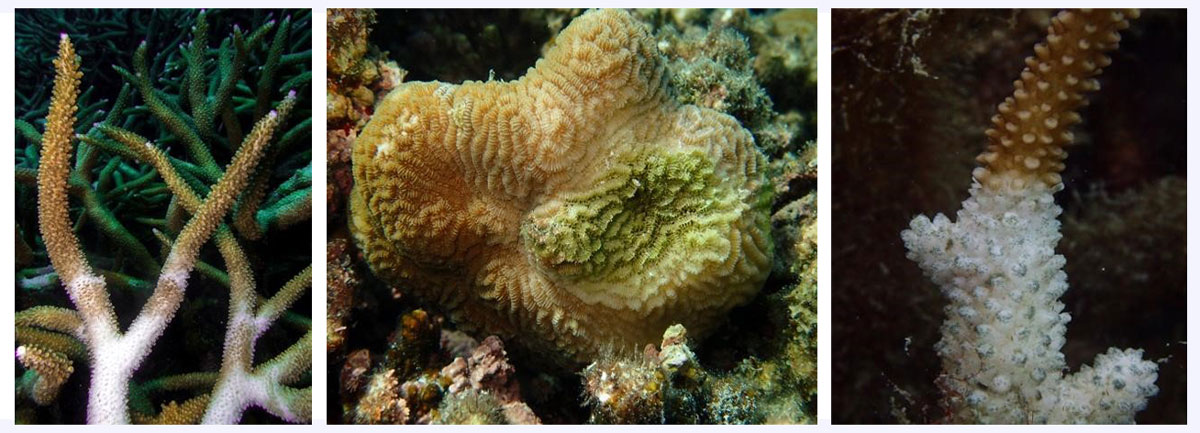Coral Disease on Koh Tao
Diseases amongst corals are becoming more prevalent since records first begun in the mid to late 20th century. This is due to a multitude of reasons, but most significantly are the increased frequency and intensity of coral bleaching events, and pollution. These both are stressors to coral colonies and leave them susceptible to disease. Since 2010, we have been tirelessly keeping up with recording data of coral disease around our little island of Koh Tao, and this last year we intensified those efforts. We collect this data so we can better understand the etiology of coral diseases and to keep track of outbreaks, and hopefully be able to one day mitigate the problems they bring.
Compared to other areas of coral biology, rather little is known about coral disease. It’s vectors, microbial agents, symptoms and etiology are all still being explored today. It is important for us to consistently monitor the health of corals, which we do in many ways. When conducting surveys it is not simply disease which we look for, it is their overall health that we are concurrently monitoring. This includes collecting information on whether there is signs of predation, bleaching, overgrowth, unusual pigmentation, growth anomalies, sedimentation and of course; if disease is present. If it is present, we take note of what kind of disease is affecting the colony, take photo documentation and make any other necessary notes on the colony.

Examples of cyanobacteria, tunicate overgrowth, and a case of extreme sedimentation damage.
We have a team of staff and long-term interns that collect the data, which we aim to collect every week. We do this along permanent transect lines which sit at five and ten meters in 11 bays around the island. This enables us to have consistent data showing any long term changes to the status of coral disease on our survey sites.
This data is incredibly important, as it provides us with the ability to determine if particular conditions seem to be increasing the likelihood of particular disease. It is acknowledged that temperature rise is likely to be an indicating factor for the beginning of an outbreak. This is important as some literature states that microbial agents for some disease (such as white syndromes) are relatively common in healthy corals, that they sit in ‘hibernation’ until the right conditions arise - much like the herpes virus sits dormant in humans until the body is under stress and cold sores are a sign of the virus ‘waking up’. Corallivorous snails, such as Drupella, have been recorded as a vector of disease transmission, and may have the capability to provide a reservoir to disease-causing bacteria or viruses over periods of relative inactivity of coral disease. These are some of the many interesting theories regarding outbreak causes of this fascinating problem. Further study is required to properly understand the nature of the diseases we are facing today. We aim to continue our data collections, and ideally start further research to learn more, and eventually have the ability to counteract the degradation which our reefs face, and share this incredibly important information with others.
Some of the coral disease which we see here around Koh Tao include; brown band disease (BrB), black band disease (BBD) yellow band disease (YBD), white syndrome (WS), and skeletal eroding band (SEB). Of these we find WS the most along our transect lines. In saying this however, we are always on the lookout and often come across BRB and SEB on dives when we are not collecting data.

Examples of our three most commonly seen diseases: Brown Band Disease (BrB), White Syndrome (WS), and Skeletal Eroding Band (SEB).
So far, we have found that diseases such as BrB and SEB mostly affect the fast growing coral genera such as Acropora and Pocillopora, while WS seems to have a slight preference for the slower growing colonies such as the sub massive Porites. Overall though, WS does affect a broad range of coral genera and growth forms.

An example of how quickly Brown Band Disease (BrB) can kill a large Acropora colony.
It is also becoming more apparent that corals on our shallow (5m) transect lines are more likely to have their health compromised. This could be attributed to a variety of reasons, such as that shallower lines are more regularly hit with warmer surface waters than those corals of the deeper lines. Much literature suggests that coral disease can be activated by warmer waters, and it would also make sense that due to additional heat stresses that they are more heavily affected by overgrowth and other competitors. The shallower waters also get hit with the most pollution, nutrients, and sediment from land runoff - which affects their ability to compete with other marine organisms such as algae.
Understanding the nature of coral diseases can provide us with insights to how we may be able to manage and control disease in future. Our team is very excited to continue taking this vital data and expanding our understanding of coral threats and how we can mitigate them this coming year.
To learn more about coral diseases on Koh Tao, check out these publications:
- Assessing baseline levels of coral health in a newly established marine protected area in a global scuba diving hotspot. Margaux Y. Hein, Joleah B. Lamb, Chad Scott, Bette L. Willis
- Dietary shift in corallivorous Drupella snails following a major bleaching event at Koh Tao, Gulf of Thailand. B.W. Hoeksema, C. Scott & J.D. True
- Scuba diving damage and intensity of tourist activities increases coral disease prevalence. Joleah B. Lamb, James D. True, Srisakul Piromvaragorn, Bette L. Willis
- Bacterial profiling of White Plague Disease in a comparative coral species framework. Cornelia Roder, Chatchanit Arif, Till Bayer, Manuel Aranda, Camille Daniels, Ahmed Shibl, Suchana Chavanich, and Christian R Voolstra
- Tracing Anthropogenic Nutrient Inputs Using δ15N Levels in Algae Tissue Koh Tao, Thailand. Laurence Romeo, MAS Marine Biodiveristy and Conservation
